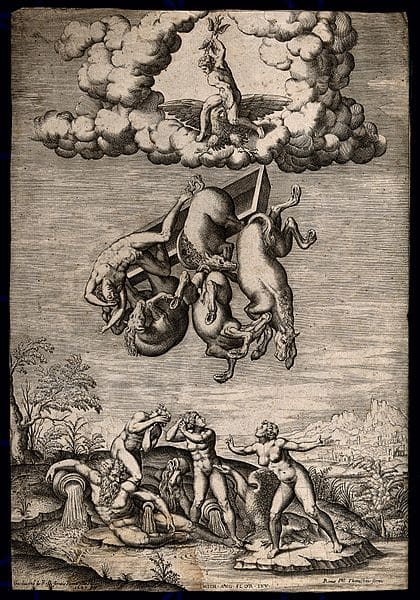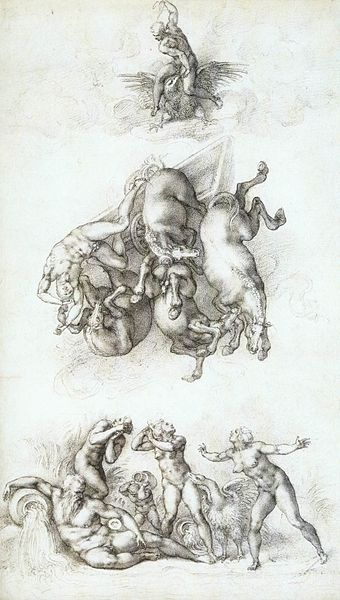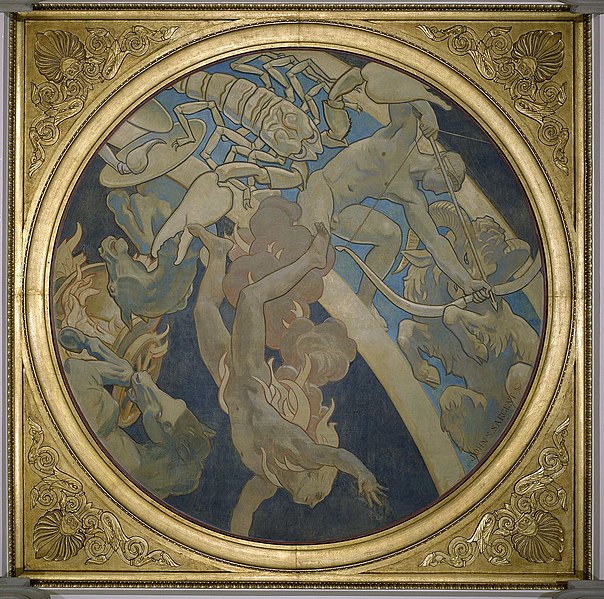When we dive into the vast ocean of Greek mythology, we encounter tales of gods, heroes, and mortals that have shaped Western culture for millennia. Among these tales, the tragic story of Phaethon, the young son of the Sun God Helios, stands out as a cautionary tale about the dangers of hubris and the consequences of overreaching one’s abilities.
Phaethon Key Facts
| Parents | Helios (Sun God) and Clymene |
| Partners | None |
| Siblings | The Heliades (sisters) |
| Offspring | None |
| Other names | None |
| Roman name | Phaeton |
| The God of | None (He was a mortal) |
| Symbols | Sun chariot, Falling star |
Name and Etymology
The name “Phaethon” is derived from the Greek word “phaetho,” which means “to shine” or “to blaze.” It’s a fitting name for the son of the Sun God, symbolizing brightness and radiance. In Roman mythology, his name remains largely unchanged as “Phaeton.” Throughout various texts, he’s often referred to with epithets that highlight his close association with the sun and his tragic fate, such as “the ill-fated youth” or “the fallen star.”
Phaethon’s tale is one of the few in Greek mythology where the name of the protagonist directly correlates with their story’s outcome. The imagery of a blazing, shining entity plummeting from the sky is encapsulated in his very name. This connection between name and fate is a recurring theme in many mythological tales, emphasizing the inescapable nature of destiny.
Lastly, while Phaethon doesn’t have many alternative names or titles, his story’s impact is so profound that his name has become synonymous with catastrophic falls and uncontrolled disasters, especially those resulting from youthful arrogance or overambition.

Phaethon’s Origins
Born to Helios, the Sun God, and Clymene, a nymph, Phaethon was raised without the knowledge of his divine heritage. His mother often spoke of his father’s radiant glory, but without tangible proof, Phaethon faced ridicule from peers who doubted his lineage. This doubt planted a seed of insecurity, driving him to seek validation and proof of his divine descent.
Guided by his journey, he reached the palace of the Sun. There, Helios warmly welcomed him. Overwhelmed by the reunion, Helios, in a moment of affection, promised to grant Phaethon any wish. This promise would set the stage for the tragic events that followed. The tale of Phaethon is not just about his personal quest for identity but also serves as a reflection on the dangers of unchecked desires and the responsibilities that come with power.
In Greek mythology, Daemones or personified spirits often play pivotal roles, guiding or influencing the actions of gods and mortals. In Phaethon’s tale, it’s the Daemon of Pride that can be seen influencing his tragic decision to drive his father’s sun chariot, a task he was woefully unprepared for.

Relationship with Helios
Helios, the Sun God, loved his son deeply. When Phaethon approached him, seeking validation of his lineage, Helios, in a moment of paternal affection, promised to grant him any wish. This promise, made without forethought, would lead to catastrophic consequences. Their relationship serves as a poignant reminder of the complexities of parent-child relationships and the unintended consequences of promises made in haste.
Depiction And Characteristics
Often depicted as a young, handsome youth, Phaethon’s most iconic representation is him losing control of the sun chariot. Symbols associated with him include the sun, the chariot, and a falling star or meteor, representing his tragic fall from the sky.
Driven by a desire to prove himself and validate his lineage, Phaethon was determined, albeit naive. His youthful arrogance and desire for validation led him to make impulsive decisions without considering the consequences. His story serves as a cautionary tale about the dangers of hubris and the importance of understanding one’s limitations.
Phaethon’s Symbols and Role
Phaethon is closely associated with the sun chariot, representing his brief yet catastrophic attempt to control the sun’s path across the sky. Another symbol tied to his tale is the falling star or meteor, symbolizing his tragic descent from the heavens. While not directly associated with specific animals or plants, his story’s impact on the Earth, causing scorching heat and widespread fires, ties him to themes of destruction and rebirth.
Phaethon’s primary role in Greek mythology is as a cautionary figure. His tale serves as a warning about the dangers of overreaching one’s abilities and the catastrophic consequences of unchecked ambition. In many ways his story resembles that of Icarus, who flew too close to the sun. While he did not have specific responsibilities or roles as a god or hero, his story’s lessons have left an indelible mark on the tapestry of Greek myths.

Myths about Phaethon
The tale of Phaethon is one of ambition, identity, and tragic consequences.
Phaethon and the Sun Chariot
Among the most iconic myths, Phaethon boldly asked to drive his father’s sun chariot. After Helios granted him a wish, Phaethon, eager to prove his divine lineage, decided to take the reins of the sun chariot for a day.However, the powerful steeds, sensing his inexperience, went astray. They veered off course, scorching the Earth and causing chaos. The world was set ablaze, with forests burning and rivers drying up. To prevent further disaster and save the Earth from utter destruction, Zeus intervened. With a heavy heart and no other choice, he struck down Phaethon with a thunderbolt. This act ended the young man’s short-lived journey and caused him to fall from the sky, leaving a blazing trail reminiscent of a shooting star.
The Mourning of the Heliades
Following Phaethon’s tragic fall, his sisters, the Heliades, were consumed by grief. They gathered by the banks of the Eridanus river, where Phaethon had fallen, and mourned his loss. Their sorrow was so profound that the gods took pity on them. In their deep sorrow and to honor Phaethon’s memory, the Heliades transformed into poplar trees. Moreover, their tears became amber, and even today, people find this amber by the riverbank, actively showcasing their enduring love and loss.

Representations Of Phaethon In Art
Phaethon’s tragic tale has inspired countless artists throughout history. His fall from the sky, the uncontrolled sun chariot, and the scorched Earth are recurring themes in various artworks. These depictions often focus on the dramatic moment when Zeus strikes him down, capturing the raw emotion and the catastrophic consequences of his actions.

Mentions in Ancient Texts
Ovid’s “Metamorphoses”
Written in the 1st century AD by the Roman poet Ovid, “Metamorphoses” is a magnum opus that chronicles the history of the world from its creation to the deification of Julius Caesar. He captures the essence of Phaethon’s quest for identity, his tragic decision, and the subsequent fallout. A poignant quote from this work reads:
“He whom the world could not contain, a world in ruins, behold him there.”
Hesiod’s “Theogony”
Hesiod, a Greek poet from the 8th century BC, is often considered a contemporary of Homer. In his work “Theogony,” which details the origins and genealogies of the Greek gods, Phaethon’s lineage and connection to the Sun God Helios are briefly mentioned. Hesiod’s writings provide valuable insights into the early Greek understanding of divine genealogies and relationships.
Nonnus’ “Dionysiaca”
Composed in the 5th century AD, “Dionysiaca” by Nonnus is an epic tale centered around the god Dionysus. While the primary focus is on Dionysus, Nonnus also touches upon other myths, including that of Phaethon. His account offers a slightly different perspective, emphasizing the cosmic consequences of Phaethon’s actions. Nonnus describes the event with vivid imagery, stating:
“The burning axle scorching the tracks of the stars in the sky.”
Frequently Asked Questions
Driven by his hubris and eagerness to prove himself, Phaethon took the reins of his father’s sun chariot. However, he was not ready for such a task, and consequently, he met a tragic fall.
To prevent further chaos and destruction, Zeus intervened and struck down Phaethon with a thunderbolt.
After being struck by Zeus, Phaethon fell into the Eridanus river.
No, Phaethon was a mortal, the son of the Sun God Helios and the nymph Clymene.
Phaethon’s story serves as a cautionary tale about the dangers of hubris and the consequences of overreaching one’s abilities.
Featured Image Credit: John Singer Sargen, Public domain, via Wikimedia Commons

